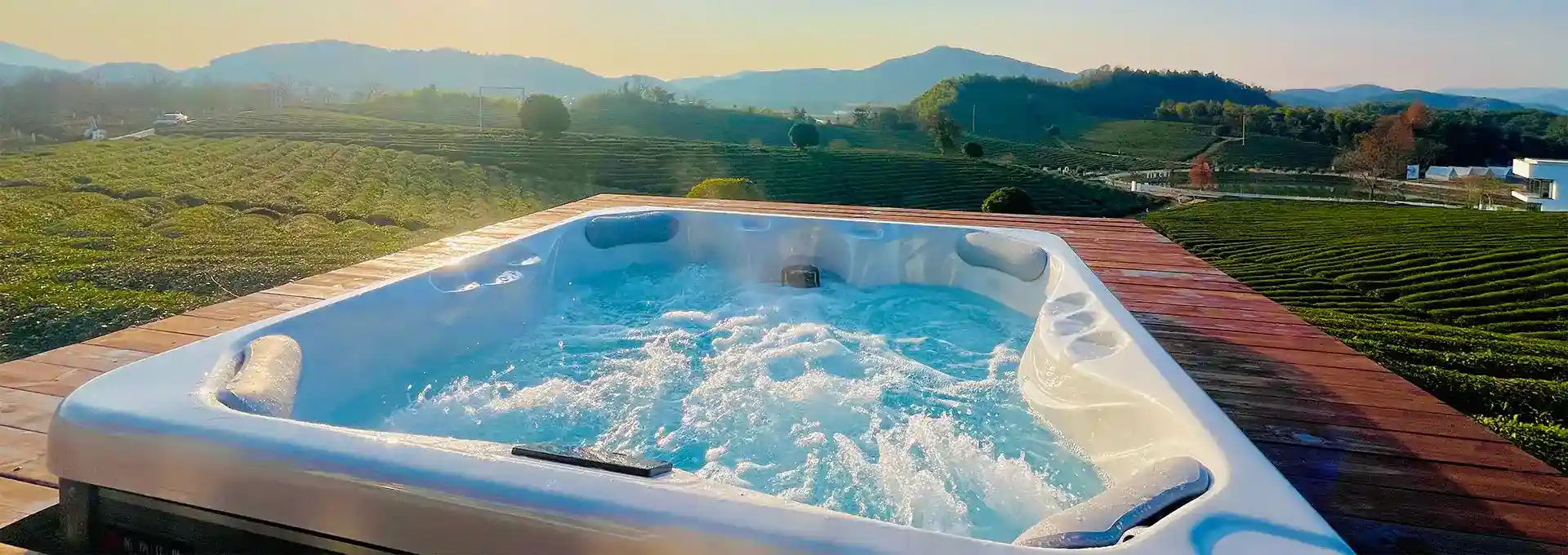Why Are There Bubbles in My Hot Tub?
2024-08-09 17:45:55
Bubbles in a hot tub are more than just a visually pleasing feature; they play a crucial role in the overall hot tub experience. These effervescent wonders are created by jets that force air into the water, resulting in the formation of countless tiny bubbles. While they may seem like a simple aesthetic touch, bubbles serve multiple purposes in your 6-seater hot tub, from enhancing relaxation to aiding in water circulation and even contributing to the cleanliness of your spa. Understanding the science and benefits behind these bubbles can help you appreciate your hot tub experience even more.
How much does a 6-seater hot tub cost?
The cost of a 6-seater hot tub can vary significantly depending on various factors such as brand, features, materials, and overall quality. On average, you can expect to pay anywhere from $3,000 to $15,000 or more for a 6-seater hot tub. Entry-level models often fall in the $3,000 to $5,000 range, while mid-range options typically cost between $5,000 and $10,000. High-end luxury 6-seater hot tubs can easily exceed $10,000 and sometimes reach $20,000 or more.
When considering the cost of a 6-seater hot tub, it's essential to look beyond the initial purchase price. Additional expenses to factor in include:
1. Installation costs: This can range from $500 to $3,000 or more, depending on the complexity of the installation and whether you need to prepare a foundation or run electrical lines.
2. Ongoing maintenance: Regular maintenance, including water treatment chemicals, filter replacements, and occasional professional servicing, can cost $50 to $100 per month.
3. Energy costs: The electricity required to run a 6-seater hot tub can add $20 to $50 to your monthly energy bill, depending on usage and local electricity rates.
4. Accessories: Items like covers, steps, lighting, and water care systems can add several hundred to a few thousand dollars to your total investment.
5. Potential repairs: While quality hot tubs are built to last, you may need to budget for occasional repairs over the life of the tub.
When shopping for a 6-seater hot tub, consider factors such as energy efficiency, insulation quality, and warranty coverage. These features may increase the upfront cost but can lead to significant savings over time. Additionally, look for models with powerful jets, comfortable seating arrangements, and user-friendly control systems to ensure you're getting the most value for your investment.
It's also worth considering the long-term benefits of owning a hot tub. Regular use can contribute to improved physical and mental well-being, potentially reducing healthcare costs over time. Moreover, a well-maintained hot tub can increase your property value and create a luxurious outdoor living space for entertaining friends and family.
What size is a 6-person hot tub?
The size of a 6-person hot tub can vary depending on the manufacturer and specific model, but generally, these spas fall within a certain range of dimensions. Typically, a 6-person hot tub measures between 7 to 8 feet in length and width, with depths ranging from 30 to 40 inches. However, it's important to note that these dimensions can fluctuate, and some models may be slightly larger or smaller.
When considering the size of a 6-person hot tub, it's crucial to take into account several factors:
1. Seating arrangement: Some 6-person hot tubs may have a more compact design with efficient use of space, while others might offer more generous seating with additional legroom.
2. Shape: Hot tubs come in various shapes, including square, rectangular, round, or triangular. The shape can affect the overall dimensions and how the tub fits into your available space.
3. Jets and features: Hot tubs with more jets or additional features like built-in coolers or waterfalls may require slightly larger dimensions to accommodate these elements.
4. Installation location: Consider not just the size of the hot tub itself, but also the space required around it for access, maintenance, and safety. A good rule of thumb is to allow at least 24 inches of clearance on all sides of the tub.
5. Weight: A filled 6-person hot tub can weigh between 2,500 to 3,000 pounds or more. Ensure your chosen location can support this weight, whether it's on a deck, patio, or indoor space.
6. Water capacity: 6-person hot tubs typically hold between 300 to 400 gallons of water. This capacity affects not only the tub's weight but also your water and energy usage.
When shopping for a 6-person hot tub, it's essential to measure your intended installation space carefully. Remember to account for any obstacles like trees, structures, or utilities that might interfere with placement. Additionally, consider how the hot tub will be delivered to your property – large models may require special equipment or access considerations.
It's also worth noting that while a hot tub may be marketed as a "6-person" model, the actual comfortable capacity may vary. Some users might find that a 6-person tub is more comfortable with 4-5 adults, especially if you prefer more space for movement or have larger individuals in your group. Always try out a hot tub before purchasing if possible, or read user reviews to get a sense of the true capacity and comfort level.
How much electricity does a 6-person hot tub use?
The electricity consumption of a 6-person hot tub can vary significantly based on several factors, including the tub's size, insulation quality, ambient temperature, and usage patterns. On average, a 6-person hot tub might use between 2,000 to 8,000 kilowatt-hours (kWh) of electricity per year, which translates to approximately $20 to $80 per month in energy costs.
To understand the electricity usage of a 6-person hot tub, consider the following factors:
1. Heater size: Most 6-person hot tubs have heaters ranging from 4 to 6 kilowatts. The larger the heater, the more quickly it can heat the water but also the more electricity it consumes.
2. Insulation quality: Well-insulated hot tubs retain heat better, reducing the need for frequent reheating and thus lowering electricity consumption. Look for models with full-foam insulation or dedicated insulation panels.
3. Cover efficiency: A high-quality, well-fitting cover can significantly reduce heat loss when the tub is not in use, saving on electricity costs.
4. Ambient temperature: Hot tubs in colder climates will use more electricity to maintain water temperature compared to those in warmer regions.
5. Usage frequency: More frequent use means more frequent heating, which increases electricity consumption.
6. Temperature settings: Higher temperature settings require more energy to maintain. Lowering the temperature by just a few degrees when the tub is not in use can lead to significant energy savings.
7. Pump efficiency: Modern, energy-efficient pumps can reduce electricity consumption compared to older models.
8. Smart controls: Some hot tubs come with smart controls that allow for more efficient heating cycles and energy management.
To minimize electricity usage and costs associated with your 6-person hot tub, consider the following tips:
1. Invest in a high-quality cover and use it consistently when the tub is not in use.
2. Set the temperature a few degrees lower than you typically prefer, then raise it slightly before use.
3. Use the hot tub's economy mode when you're away for extended periods.
4. Regularly maintain your hot tub, including cleaning filters and checking for leaks, to ensure optimal performance.
5. Consider using a timer to heat the tub during off-peak electricity hours if your utility offers time-of-use rates.
6. Explore renewable energy options like solar panels to offset your hot tub's electricity consumption.
7. Choose a model with energy-efficient features like LED lighting and variable-speed pumps.
When shopping for a 6-person hot tub, pay attention to energy efficiency ratings and look for models certified by energy-saving programs. While these models may have a higher upfront cost, they can lead to significant savings on your electricity bill over time.
It's also worth noting that the cost of operating a hot tub extends beyond just electricity. Factor in costs for water, chemicals, and regular maintenance when budgeting for your hot tub ownership. By choosing an energy-efficient model and implementing smart usage habits, you can enjoy the benefits of your 6-person hot tub while keeping electricity costs manageable.
If you want to get more information about this product, you can contact us at info@iparnassus.com!
References:
1. Bullfrog Spas. (2021). Hot Tub Pricing Guide.
2. Swim University. (2022). Hot Tub Sizes: What You Need to Know Before Buying.
3. Energy.gov. (2023). Energy-Efficient Home Design.
4. Hot Spring Spas. (2022). Hot Tub Energy Efficiency Guide.
5. Jacuzzi. (2021). Hot Tub Buyer's Guide.
6. Master Spas. (2023). Hot Tub Installation Guide.
7. Aqua Magazine. (2022). The Real Cost of Hot Tub Ownership.
8. Pool and Spa News. (2021). Understanding Hot Tub Energy Consumption.
9. Home Advisor. (2023). How Much Does a Hot Tub Cost?
10. Caldera Spas. (2022). Hot Tub Energy Efficiency Tips.



